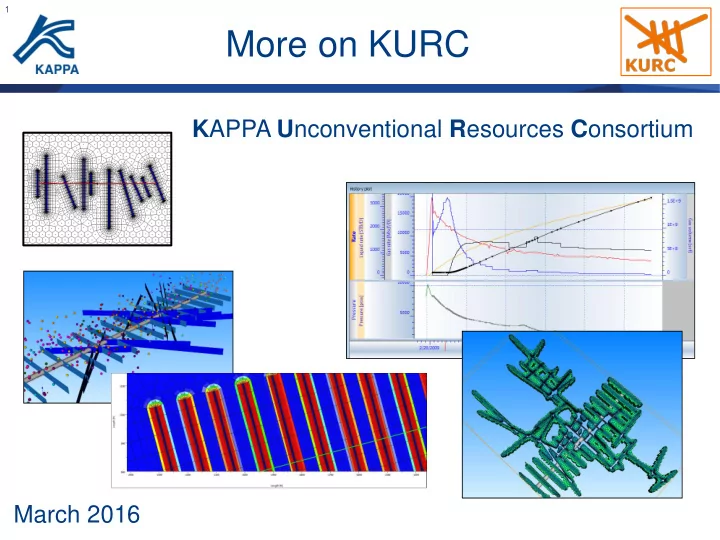

1 More on KURC K APPA U nconventional R esources C onsortium March 2016
2 KURC-1 (2011-2014) • 28 member companies • Data analysis of shale plays • KURC software application • 3-year software exclusivity • 150,000 € per participant
3 KURC-1 members
4 Budget and expenses
5 KURC application
6 KURC application
7 KURC-1 developments 1. Loglog analysis tools (*) 2. Fast analytical / numerical: SRV, trilinear (*) 3. Complex geometries (*) 4. Generalized pseudofunctions (*) 5. Discrete Fractures Networks (DFN) 6. Water flowback 7. Single well statistical EUR 8. Use Microseismic / Fracturing software results 9. Confined PVT (*) public in March 2016
8 Loglog analysis tools k L w x X f k x N² x X f ²
9 Fast models (e.g. SRV)
10 Complex MFHW models
11 Pseudofunctions • Pseudopressure correction • m (p), Z(p) • k(p) • Pseudotime correction • c(p * (t)) • F (p * (t)) • Desorption
12 Analytical & numerical DFN
13 Modelling water flowback
14 Statistical EUR EUR
15 Import from microseismics
16 Import from fracturing software
17 Confined PVT • Eagle Ford Oil 1600.0 1200.0 11 components Pressure (psia) Confinement = 10 nm pore radius 800.0 Conventional Validated against CSM models 10 nm 400.0 7.80E-02 0.0 10 nm 0.0 200.0 400.0 600.0 800.0 Viscosity (cp) Temperature ( o F) Conventional 7.40E-02 7.00E-02 0 500 1000 1500 2000 Pressure (psia)
18 KURC-2 (2015-2016) • KURC-1 membership required • Topics from KURC-1 members • 50,000 € for KURC -1 member • 200,000 € for new members
19 KURC-2 developments 1. Multiple well interferences in DFN’s 2. Fast Marching methods for DFN’s 3. 3-D DFN’s 4. Stochastic DFN’s from Microseismics 5. Connection to Geomechanics software 6. Enhanced permeability regions 7. Multiphase wellbore model for CSG
20 DFN interferences
21 Fast Marching FMM Interference times DFN realizations Constrain DFN realizations to interference times FMM History match Simulation models DFN realizations
22 3-D DFN’s
23 DFN from Microseismics
24 Geomechanics Flow module (with pressure – dependent k and ) … time k, P T0 T1 T2 Geomechanical module At the end of each exchange time increment : • Mechanical module reads in new pore pressures • Mechanical module calculates new stresses and induced deformations • Mechanical module (or flow module) computes new permeability/porosities from the knowledge of strains/effective stresses • Flow module reads in the new flow properties and use it in computations for the next time increment
25 Enhanced k regions
26 CSG wellbore model
Recommend
More recommend